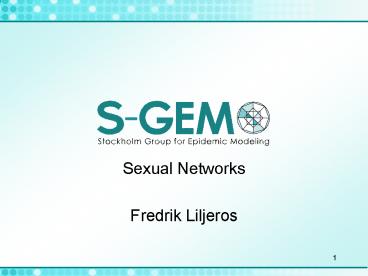Sexual Networks PowerPoint PPT Presentation
1 / 46
Title: Sexual Networks
1
- Sexual Networks
- Fredrik Liljeros
1
2
Stockholm Group for Epidemic Modelling,S-GEM
3
Stockholm Group for Epidemic Modelling,S-GEM
- Johan Giesecke ECDC/KI Åke Svensson SMI/SU
Tom Britton SU
Karl Ekdahl Magnus
Boman KTH/SICS
4
The Swedish problem
Incidence of Chlamydia Sweden
Cases per 100 000
Year
5
The theme for today
How is it possible for Sexually transmitted
Infections (STIs) to reproduce themselves when
the average reported life number of contacts are
as low as 6-12 in western societies?
Why do we have STIs at all?
6
Outline
- Data sources
- Structural properties that facilitate the spread
of STI - Conclusions
7
Data sources
- Clinical data
- Network data
- Validity?
- Representative?
- Local networks
- Network data
- Validity?
- Representative?
- National surveys
- Representative
- Validity?
- Low Response rate
- Only ego network data
- Online networks
- Network data
- Validity?
- Representative
8
Triangulation
9
We must take the variation into consideration
when we calculate R0 (the epidemic threshold) for
STI
Newman Social Networks (2003) Pastor-Satorras, R
and A Vespigiani (2001) May and Anderson Nature
(1987)
10
On average, your partners have more partners than
you !
Newman Social Networks (2003) May and Anderson
Nature (1987)
11
The core group theory
12
Scale free distribution of partners
Liljeros et al Nature (2001)
National survey data
13
The British National survey NATSAL 2000
14
Gay men attending a STI clinic in London
Colgate et al PNAS (1989)
15
Internet contact site data
Holme, Edling and Liljeros Social networks 2003
16
Where are the fat tails coming from?
17
Preferential attachment ?
18
A
19
A
B
20
B
A
C
21
B
A
C
D
22
D
B
A
C
E
23
D
E
B
A
C
F
24
D
F
B
A
C
E
G
25
(No Transcript)
26
Proportional preferential attachment
27
Four types of preferential attachment
Krapivsk, P.L., Redner, S., and F. Leyvraz, PRL
2000
28
Measuring preferential attachment
29
cum degree increase, ? t
cum degree increase, ? t
Degree at time t liftime -1 year
Degree at time t -3-1 year
Blasio, B. F. Svensson, A and F Liljeros (2007)
Preferential attachment in sexual networks.Proc
Natl Acad Sci U S A 104(26) 10762-7
30
sparse data!
Blasio, B. F. Svensson, A and F Liljeros (2007)
Preferential attachment in sexual networks.Proc
Natl Acad Sci U S A 104(26) 10762-7
31
The MLE model
Blasio, B. F. Svensson, A and F Liljeros (2007)
Preferential attachment in sexual networks.Proc
Natl Acad Sci U S A 104(26) 10762-7
32
Results
33
(No Transcript)
34
Potential preferential attachment mechanisms
- Individuals increase their skills
- Individuals preferences for stable monogamous
relationship decreases over time when they are
single - Individuals with many partners becomes more
attractive
35
The hubs may not be as important as previously
thought!
36
Peoples number of sex acts are not very
correlated with number of partners
Nordvik, M. K. and F. Liljeros (2006).
"Transmission of sexually transmitted
infections." Sexually Transmitted Diseases 33(6)
342-349.
37
The hubs may not be as important as previously
thought!
Nordvik, M. K. and F. Liljeros (2006).
"Transmission of sexually transmitted
infections." Sexually Transmitted Diseases 33(6)
342-349.
38
Concurrency
Contact
network
Line
graph
Kretzchmar and Morris Social Networks (1995)
39
Concurrency and HIV
40
A more likely heterosexual network structure for
HIV transmission
41
The small world effect
?
42
(No Transcript)
43
Nordvik, M. K., F. Liljeros, et al. ( 2007).
"Spatial Bridges and the Spread of Chlamydia The
Case of a County in Sweden. Sexually Transmitted
Diseases.
44
Conclusions
- Standard deviation is of high importance
- Other mechanisms may also play an important role.
- We need to take the specific infection into
consideration. - We need more detailed data!
45
Future research
- Dynamic weighted networks
- Dynamic weighted networks
- Dynamic weighted networks
46
Take home message
- Your students partners have had more partners
than your students have!

